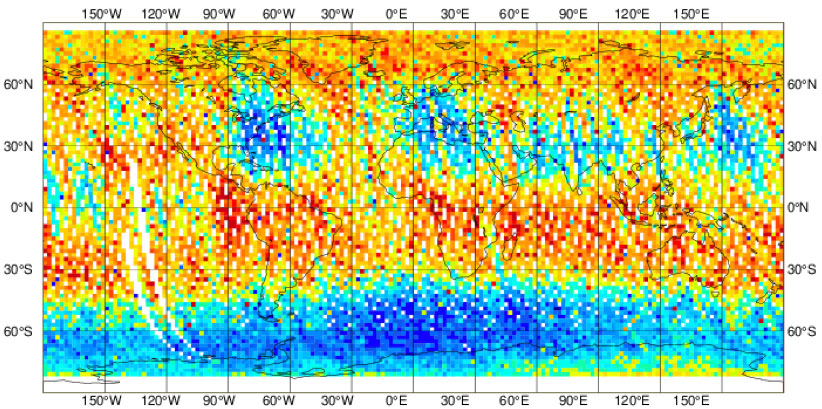- News
- Mirror bias correction brings ...
Mirror bias correction brings higher quality to Aeolus data
20 May 2020
Part of ESA's Earth Explorer family, Aeolus was launched on 22 August 2018 and is the first satellite mission to directly acquire profiles of Earth's wind on a global scale. Its data has already been used to improve the accuracy of numerical weather prediction (NWP) models and plays an important role in the advancement of our understanding of tropical dynamics and processes relevant to climate variability. Recently, Aeolus has taken one leap further: on 12 May 2020, its wind data, that was previously accessible only to expert user groups involved in validation activities, became publically available.
This was made possible due to the tireless product optimisation work performed by the experts of the Aeolus Data Innovation and Science Cluster (Aeolus DISC) supporting ESA's Mission and Ground Segment teams and complemented by a global team of independent validation experts.
An important goal of the product optimisation activities was to assess whether the tools developed before launch for calibration and systematic error correction yielded the desired results in application. Systematic errors show up as biases in the wind product and, if not corrected, can be detrimental for weather forecasts in which that wind data is used.
The mirror temperature-based bias

When Aeolus winds were compared against the European Centre for Medium-Range Weather Forecasts (ECMWF) model winds, it was found that the existing bias correction tool, that was built to detect latitude-dependant biases by evaluating ground echoes of the laser, was not sufficient for the correction of the actual observed variations, which included longitudinal components.
In September 2019, Aeolus DISC scientists made significant progress in understanding the wind biases when comparing their characteristics to the housekeeping information available from the satellite. They discovered that the biases were strongly related to small thermal variations across the large telescope mirror (M1).
The M1 mirror temperatures vary along the orbit in response to different radiation leaving the atmosphere. The temperature variations of only up to 0.3 K are assumed to cause small changes in the pointing of the laser light received back from the atmosphere. The instrument is sensitive to the change in angle of the incoming laser light and therefore produces an apparent frequency shift and hence a wind bias.
The correction of the bias

The improved understanding of the relationship between the mirror temperature and the wind bias allowed for the development of a Near Real Time (NRT) bias correction procedure using the M1 temperatures as predictors. The procedure is also designed to account for additional biases associated with certain drifts within the instrument, by tuning the configuration of the bias correction once per day, using monitoring statistics based on the ECMWF model winds.
Before the activation of the new bias correction method, several forecast centres involved in validation activities had already shown the positive impact of Aeolus wind data on forecasts when assimilated into their models in off-line experiments. ECMWF started to assimilate Aeolus data in their operational forecasts in January 2020, using an internal bias correction based on their model winds.
However, to ensure that the wind data would be useful to a broader set of forecast centres and for scientific exploitation, a reduction of biases to around 1m/s had been identified as a prerequisite for the Aeolus public data release.
The telescope temperature-based bias correction was activated on 20 April and was the last and largest missing puzzle piece needed to assure NRT production of low bias wind data that would be ready to be assimilated into NWP models and used for scientific applications.